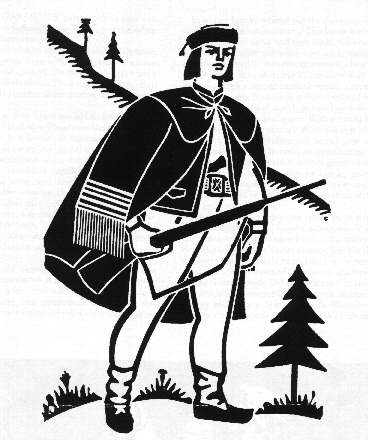 Garment of Andrew Savka
(1619-1661) the Lemko "Robin Hood." Woodcut by O. Velychko
Garment of Andrew Savka
(1619-1661) the Lemko "Robin Hood." Woodcut by O. VelychkoLemko Heritage
Lemko Garments
by Tasia Hontar, Forum #70 - Summer 1987
 Garment of Andrew Savka
(1619-1661) the Lemko "Robin Hood." Woodcut by O. Velychko
Garment of Andrew Savka
(1619-1661) the Lemko "Robin Hood." Woodcut by O. Velychko
All Lemko garments, particularly in their cut, and decorative techniques are evidence of the subtle aesthetic taste of their creators.
Lemko women usually dressed in a chemise, a skirt, a kind of apron, a sleeveless blouse and, in winter time, a sheepskin coat (jacket). On their heads they wore a hood or a kerchief (babushka). Their footwear more often than not consisted of leather shoes (postoly) or boots (choboty).
Sorochka (blouse / shirt / chemise). In Lemkovyna, it was known as oplicha or chakhlyk. These sorochka blouses were made of homespun hemp (for daily wear) and flax (worn on special occasions). These were smooth or seamless cut - in other words, the sleeves were sewn to the shoulders parallel-like, gathered up round the obshyvka collar, and down at the cuffs. What was special about the sorochka Lemko kind of women's bodice / blouse was that they cut it waist short. Its lower part, missing as it was, was made up for by the podolok white skirt of rougher linen. It was tied about the waist by a length of cord. Blouses worn by girls as well as women were always livened up by whimsical patterns or needlework.
Most of the Lemko blouses feature cross-stitch at the sleeve and narrow hem-stitch at the cuff. The women generally used yellow, green and red threads against a red background, working their ornamental motifs into the shape of crosses, rhombuses or even eight leaf rosette like patterns.
In winter, Lemko women put the spindytsia skirts on top of their podolok counterparts. The latter were known as fartukh, litnyk or kabat and were made of homespun wool. In summer, similar garments were used, made of vybilka print cloth, dyed by itinerant craftsmen. These skirts were usually dark blue, even black, complete with tiny ornamental patterns shaped as small wheels, pepper grains or outlined as mere dots. Such a skirt consisted of five gores (long tapered pieces of cloth) gathered up as so many right little folds and sewn to the belt. With growing factory output in the early 20th century, skirts like that started being produced, using manufactured fabrics that were either monotones or prints. In order to save on material, coarser lined was applied to make the front gores, covered by the apron. Usually, all skirts worn by Lemko women for special occasions were trimmed at the lower section, boasting several rows of narrow sewn-on color stripes, popularly known as farbytky.
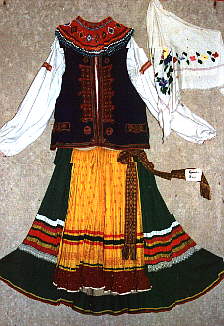 Lemko women's clothing
from Komancha - Sanok region.
Lemko women's clothing
from Komancha - Sanok region.
Apron. Worn on top of the spidnytsia or skirt, this garment was traditionally known as zapaska. It was usually cut and sewn using the same fabric as the spidnytsia skirt, if not finer in quality or whiter in color. Just like the spidnytsia, every zapaska would be pleated ever so neatly and livened up by the addition of color bands and laced flounces.
Sleeveless blouse. Otherwise known as lebyk or korset, this kind of women's garment was impressive with its beauty and unique decorations. Ya. Holovatsky, a well known scholar, wrote at the end of the 19th century that neither a maiden nor a married woman would ever dare put in an appearance at work, unless she had a bodice like that securely on. A lebyk was usually made of factory produced black, blue or navy-blue cloth, trimmed by the chain or the trestle type needlework, done using red thread plus fine yellow metal buttons of brass. The colors of the needlework blended harmoniously with those apparent on the sleeveless bodice.
Footwear. Postoly, also known as khodaky or kerptsi, is the term for shoes made of home-treated leather. To wear them, one had to lace such a shoe to one's leg, using the navoloky laces or strings. On special occasions, rich Lemko women wore boots, painted yellow or black.
Headcloth. A maiden's headcloth consisted of a white homemade lined or commercial made kerchief - khutska or khustia. Married women kept their hair in a tightly twisted, small bun, clasped by a fine hazel-nut ring, known as khimlie, khomevka or khymka. Women wearing such a khimlia would always cover them under the chepets (hood, bonnet), the latter being made from florid manufactured fabric. On top of all that, they always sported and extra big, and warm babushka. The first time a girl could wear a khimlia and a chepets was during her own wedding, in the case of the traditional pochepny ritual of being dressed-up, and decorated, to face the husband-to-be. On occasion, the maids of honor, while attending to the bride's looks and costume, sang:
"She was a maiden yesterday,
She sported a garland.
Now she is a woman,
Wearing the hood."
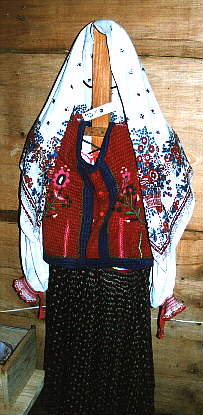 Lemko woman's clothing
from Hrab, Jaslo region
Lemko woman's clothing
from Hrab, Jaslo region
Jewelry. Jewelry formed an inseparable component of the Lemko woman's traditional dress. They put on necklaces of corals or colored strings of glass. Girls and young women also practiced wearing broad strips of colorfully embroidered cloth pinned to the necklace. It was known as basabanka.
High collars of the kraika or kryza type contributed remarkably to the treasure trove of folk ornamentation. These were made by both girls and married women. The colors of such a collar harmoniously blended with those of the accompanying, embroidered blouse (bodice) and leybyk, producing a dark or light red background to accommodate a variety of scattered rhombuses, crosses or hexagons, made of braided strings of white, blue, green, black and yellow beads.
A Lemko man usually wore a shirt, pants, a belt, a sleeveless jacket (vest), postoly shoes or choboty boots, and a hat.
Men's shirts were made of hemp or flax. They were short, hardly reaching the belt. Ethnographic sources testify that shirts worn in the late 19th century were buttoned at the back. In the villages of western Lemkovyna, they were buttoned at the shoulder. The collar was narrow, laced with a red string or fastened with a special shponks button. In that period, men's shirts were not decorated, but prior to World War I, needlework started being applied.
In summer, Lemko men wore lined pants held up by the ochkur rope (also known as nohavka or hacha). In winter, they put on white cloth trousers on top of these pants, called kholoshni or holoshni. Although held up by narrow leather belt, another broad one was worn on top, having four clasps (buckles), called cheres or yuhas.
Like the women, the men put a cloth sleeveless jacket (vest) on top of the shirt. It was known as a lebyk or bruslyk and was ornamented by needlework and metal buttons. In western Lemkovyna, such vests were embroidered at the tails and the stiff collar. The patterns used were floral - flowers, twigs, buds and leaves. The needlework was marked by a rich and clear-cut decoration.
The chuha (chuhania) was a typical Lemko outer garment in the form of a short cloak made of brown or black homespun cloth. At the back, every such chuha had a broad and long pelerine or neckerchief called halerya, ending in long toroka fringes known as svichky (literally, candles). A chuha pelerine was usually ornamented with several white stripes of broken lines. Since chuhas were worn over the shoulders, the sleeves were sewn up at the cuff. They served as extra large pockets or bags. At a Lemko wedding, the marshalok emcee always kept a bottle of alcohol down one of the chuha sleeves.
Men's footwear was similar to that of the women - the postoly shoes or choboty boots.
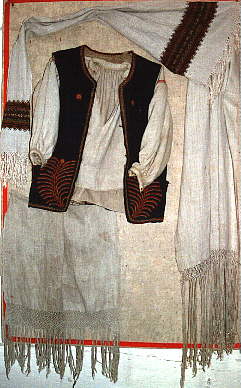 Lemko man's clothing
from Komancha, Sanok region
Lemko man's clothing
from Komancha, Sanok region
In summer, the Lemko men wore the kaoap black hat, its brim bent upward. Young fellows decorated their hats with black or red feathers. In winter, men sported round sheepskin hats, the top covered with dark or light blue cloth.
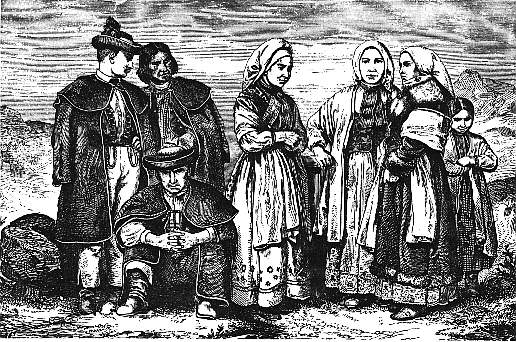
Lemkos from the village of Zavadka, Sanok county - engraved by A. Gareis, 1877.